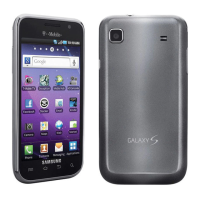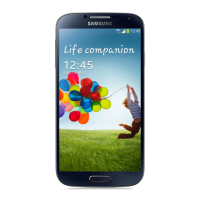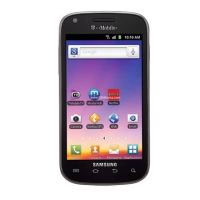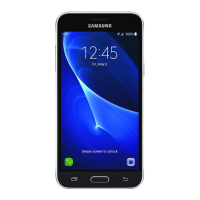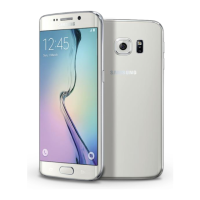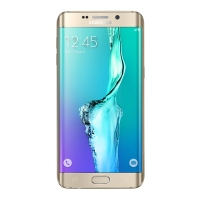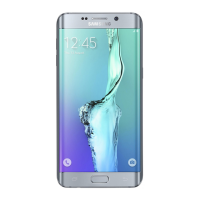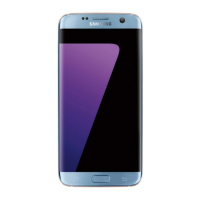Do you have a question about the Samsung Galaxy exhibit 4G and is the answer not in the manual?
Step-by-step guide for installing and removing the SIM card.
Instructions for installing the phone's battery.
Instructions for removing the phone's battery.
How to lock and unlock the phone's screen.
Steps to sign into an existing Google account on the phone.
Setting up and accessing voicemail.
Overview of the Task Manager for managing running applications.
An overview of the phone's key features and capabilities.
Customizable screen for notifications, status, and widgets.
Extra panels for more icons, widgets, and customization.
On-screen Internet search engine powered by Google.
Four shortcuts for navigation and launching functions (Phone, Contacts, Messaging, Apps/Home).
Describes common hardware and on-screen actions like Press and hold, Tap, Touch and hold.
How to navigate application menus and screens.
Web-based search engine for content on web pages.
Accesses downloadable applications and games from Android Market.
Sends and receives text and multimedia messages.
Replace default primary shortcuts with frequently used applications.
Methods for using the SD card for files and applications.
Steps to connect the phone to a PC via USB to access the SD card.
Instructions for erasing files from the SD card.
Instructions for storing and making calls using the contacts list.
How to speed dial contacts from the contacts list.
Steps to set up speed dial entries for quick dialing.
Steps to activate and connect to a Wi-Fi network.
How to initiate and use the Wi-Fi Calling feature.
Steps to set up a multi-party or conference call.
Detailed steps for initiating and managing multi-party calls.
Describes available text input methods: Samsung keypad and Swype.
Steps to enable and configure the Swype keyboard and its settings.
Advanced configuration options for Swype, including word suggestion and auto-capitalization.
Advanced XT9 settings for word completion, spell correction, and auto-substitution.
Information on saving and managing phone numbers in the contacts list.
Step-by-step guide to creating new contact entries.
Step-by-step guide for installing and removing the SIM card.
Instructions for installing the phone's battery.
Instructions for removing the phone's battery.
How to lock and unlock the phone's screen.
Steps to sign into an existing Google account on the phone.
Setting up and accessing voicemail.
Overview of the Task Manager for managing running applications.
An overview of the phone's key features and capabilities.
Customizable screen for notifications, status, and widgets.
Extra panels for more icons, widgets, and customization.
On-screen Internet search engine powered by Google.
Four shortcuts for navigation and launching functions (Phone, Contacts, Messaging, Apps/Home).
Describes common hardware and on-screen actions like Press and hold, Tap, Touch and hold.
How to navigate application menus and screens.
Web-based search engine for content on web pages.
Accesses downloadable applications and games from Android Market.
Sends and receives text and multimedia messages.
Replace default primary shortcuts with frequently used applications.
Methods for using the SD card for files and applications.
Steps to connect the phone to a PC via USB to access the SD card.
Instructions for erasing files from the SD card.
Instructions for storing and making calls using the contacts list.
How to speed dial contacts from the contacts list.
Steps to set up speed dial entries for quick dialing.
Steps to activate and connect to a Wi-Fi network.
How to initiate and use the Wi-Fi Calling feature.
Steps to set up a multi-party or conference call.
Detailed steps for initiating and managing multi-party calls.
Describes available text input methods: Samsung keypad and Swype.
Steps to enable and configure the Swype keyboard and its settings.
Advanced configuration options for Swype, including word suggestion and auto-capitalization.
Advanced XT9 settings for word completion, spell correction, and auto-substitution.
Information on saving and managing phone numbers in the contacts list.
Step-by-step guide to creating new contact entries.
| Network Technology | GSM / HSPA |
|---|---|
| 2G bands | GSM 850 / 900 / 1800 / 1900 |
| 3G bands | HSDPA 1700 / 2100 |
| Speed | HSPA 21.1/5.76 Mbps |
| GPRS | Yes |
| EDGE | Yes |
| SIM | Mini-SIM |
| Type | TFT capacitive touchscreen, 16M colors |
| Resolution | 480 x 800 pixels (~246 ppi pixel density) |
| Multitouch | Yes |
| Protection | Corning Gorilla Glass |
| Chipset | Qualcomm MSM8255 Snapdragon S2 |
| GPU | Adreno 205 |
| Internal | 4 GB, 1 GB RAM |
| Primary Camera | 5 MP, autofocus, LED flash |
| Video | 720p@30fps |
| Secondary Camera | VGA |
| Alert types | Vibration; MP3, WAV ringtones |
| Loudspeaker | Yes |
| 3.5mm jack | Yes |
| WLAN | Wi-Fi 802.11 b/g/n, hotspot |
| GPS | Yes, with A-GPS |
| USB | microUSB 2.0 |
| Sensors | Accelerometer, proximity, compass |
| Messaging | SMS(threaded view), MMS, Email, Push Email, IM |
| Browser | HTML, Adobe Flash |
| Java | No |
| Stand-by | Up to 300 h |
| Colors | Black |
| Status | Available |
| Weight | 130 g |
| OS | Android 2.3 (Gingerbread) |
| Card slot | microSD, up to 32 GB |
| Features | Geo-tagging, face detection |
| Bluetooth | A2DP |
| Radio | FM radio |
| Battery | Li-Ion 1500 mAh battery |
